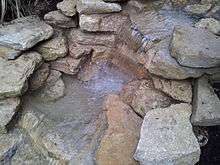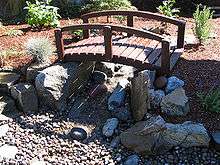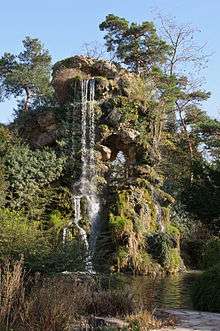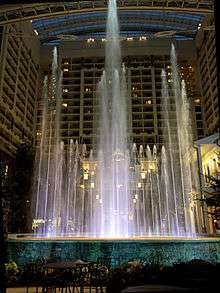Water feature




In landscape architecture and garden design, a water feature is one or more items from a range of fountains, pools, ponds, cascades, waterfalls, and streams. Before the 18th century they were usually powered by gravity, though the famous Hanging Gardens of Babylon are described by Strabo as supplied by an Archimedean screw.[1] Other examples were supplied with water using hydraulic rams.
Ancient water features were powered using gravitational forces, man power or animals to pump in the water. Since the 18th century, the majority of water features have been powered by pumps. In the past, the power source was sometimes a steam engine, but in modern features it is almost always powered by electricity. There is an increasing range of innovative designs as the market becomes more established and people become more aware of alternate installation methods, such as solar power. The advantages of using solar power include environmental benefits, no electrical lines in the garden, and free energy.
Modern water features are typically self-contained, meaning that they do not require water to be plumbed in; rather water is recycled from either a pond or a hidden reservoir, also known as a sump. The sump can either be contained within the water feature, or buried underground (in the case of an outdoor water feature).
A water feature may be indoor or outdoor and can be any size, from a desk top water fountain to a large indoor waterfall that covers an entire wall[2] in a large commercial building, and can be made from any number of materials, including stone, granite, stainless steel, resin, iron,and glass. Most water features are electronically controlled, ranging from simple timer actuators to sophisticated computerized controls for synchronizing music to water and light animation.
Water features often offer additional benefits to homeowners, such as increased curb appeal, home value, reduced noise pollution (due to the sound of water overpowering outside noise), increased humidity in dry regions and improved air quality.
History
In early modern Europe, fountains were found in the elaborate gardens of the mansions of the wealthy, and in modern times can be an element in urban design provided by the municipal authorities or public subscription. Water features are often found in gardens of middle class houses.
A notable modern example is the Diana, Princess of Wales Memorial Fountain in London, England.[3]
See also
- Musical fountain
- Rain chain
- Water garden
- Artificial waterfall
- Crystal Fountains
- Hercules monument (Kassel) - example of an almost 300-year-old water feature
- Water garden
References
- ↑ "LacusCurtius • Strabo's Geography — Book XVI Chapter 1". Retrieved 10 November 2016.
- ↑ "Wall Fountains: Shop Wall Mounted Water Features". Retrieved 10 November 2016.
- ↑ "Diana Memorial Fountain". Retrieved 10 November 2016.
External links
 The dictionary definition of water feature at Wiktionary
The dictionary definition of water feature at Wiktionary